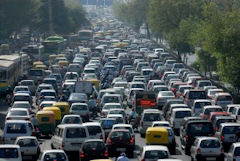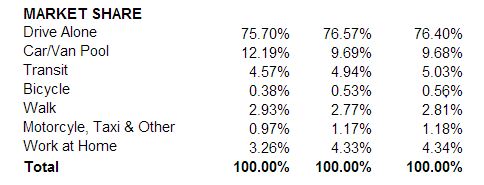Page added on September 27, 2012
Has “Peak Car” Arrived?

Worried about “peak oil?” Never fear, the world also may be reaching “peak car,” to borrow a phrase coined this summer by Scientific American. The average American is driving less and less each year — a trend matched by the citizens of economically advanced democracies across the globe, from France and Spain to New Zealand and Japan.
According to the Federal Highway Administration’s “2011 Urban Congestion Report,” three measures of congestion — daily hours of congestion, time penalty for each trip, and worst-trip time penalty — all decreased in 2011 compared to 2010. Congested hours in major metros fell nine minutes to four hours and 22 minutes.
The FHWA cited operational improvements such as tolled express lanes, accelerated bridge construction and enforceable variable speed limits. But publications like the Economist and Time draw attention to both temporary factors, such as the economic slowdown, and longer-range influences, such as the Millennial Generation’s disenchantment with automobiles.
This fast-spreading meme may be a bit over-hyped. Drive-alone commuting did decline in the past year (2010 to 2011)… by an entire 0.17%. That’s not a breathtaking shift. Mass transit, biking, walking and telecommuting all gained, but only by tiny amounts, as can be seen in this statistical summary published by geographer Wendell Cox in New Geography:
………………………………………………. 2000 2010 2011
 ………………………………………………………………………………………………………………..
………………………………………………………………………………………………………………..
Yes, Americans seems to be relinquishing their cars… but very, very slowly.
Delving deeper, one could argue that changing generational preferences will alter commuting patterns in the longer run. Nationally, the 25- to 44-year-old age cohort accounts for 43.4% of all drive-alones but 49.4% for all mass transit riders, according to the latest American Community Survey data. That 6.0 percentage point gap suggests a slight but measurable generational shift — although not one big enough to transform the transportation landscape any time soon.
(The generational preference appears to be less pronounced in Virginia. In the Old Dominion, the 25- to 44-year-old age cohort accounts for 43.7% of all drive-alone commuters and 44.9% of mass transit commuters — a gap of only 1.2 percentage points.)
On the other hand, one could argue that it is difficult for Americans to shift from cars to bikes or public transit given the non-existence of bike lanes and mass transit in many communities. As regions invest more in those options, as developers build more mixed-use projects in mass transit corridors and as people gravitate back toward the urban core, you will see the commute-by-bike and commute-by-mass transit numbers spike. I think that could happen.
The lesson here isn’t that Americans will abandon their cars in large numbers. It’s that the decades-long trend in which automobiles have steadily gained commuting market share at the expense of other transportation modes has finally plateaued, and has perhaps even gone into reverse. The numbers don’t signal a need to suddenly dump hundreds of billions of dollars into mass transit and bicycle lanes. But they do give ample reason to question long-term forecasts of ever-escalating Vehicle Miles Driven that require multi-billions of investments in road roads and highways.
Just as “peak oil” doesn’t mean that petroleum isn’t going away, “peak car” doesn’t mean that automobiles are going away. But we do have to adjust our thinking about how much money we need for transportation and where we need to put it.
4 Comments on "Has “Peak Car” Arrived?"


BillT on Thu, 27th Sep 2012 6:18 am
And then there are record sales in China, India, and many other 3rd world countries. If I remember recent article that said that China sold more cars than the US this year and demand is still strong. Of course they are not buying huge SUV gas hogs, but they are still buying by the millions.
As long as Big Oil is in control, there will be little spent on ‘alternative’ transportation. But, you can do it on your own. Just buy a bike or walk when you can. Think how healthy you would be if you spent a few hours on Saturday walking down to the local grocery store and humping groceries home in your own wheeled cart instead of riding around 18 holes spending money and time for nothing. You could cut out that paid gym membership if you used muscle power more.
deedl on Thu, 27th Sep 2012 6:46 am
Peak Car is a consequence of Peak Oil. It is simple economics to understand this. In a quantity-price-diagram peak oil does simply mean the supply curve shifts left, because the available quantity decrases. This results in a new market equilibrium with a higher price and a lower quantity. So whoever argues that peak oil doesn’t matter due to peak demand does not understand most simple economics. Peak Car as an example for peak demand does not protect us from the consequences of peak oil but is a consequence of peak oil.
@BillT: It is quite simple to explain why in china car demand is still increasing. The price-quantity-model does not include dynamics, it just says where the new equilibrium is, not how fast do we get there. Since the US have a very high per-capita-consumption of mobility and china a very low one, it is quite probable that the global market equlibrium is somewhere in between. Therefore economics predict an increase of mobility in china and a decrease in US. In the long term the equlibrium will move below the chinese per capita consumption of mobility. BTW, the chinese government is thinking about taxing fuel, because they are so dependent on imported fuel, so there are limits to mobility growth in china, and theye are not too far away.
Kenz300 on Fri, 28th Sep 2012 11:10 pm
We will need options in order to change from using the automobile for transportation. Better walking and bicycle paths need to be constructed that connect work, homes and schools. Better and more convenient mass transit needs to be available for longer distances. Trains and trolleys are pretty efficient modes of transportation. We need more of them.
SilentRunning on Sat, 29th Sep 2012 12:18 pm
With average wages stagnant – (which means shrinking in real terms) & gas prices exploding it doesn’t take an economics degree to see that more and more people are being priced out of automobile ownership. I’ve seen this with my own children, who are now in their 20s.